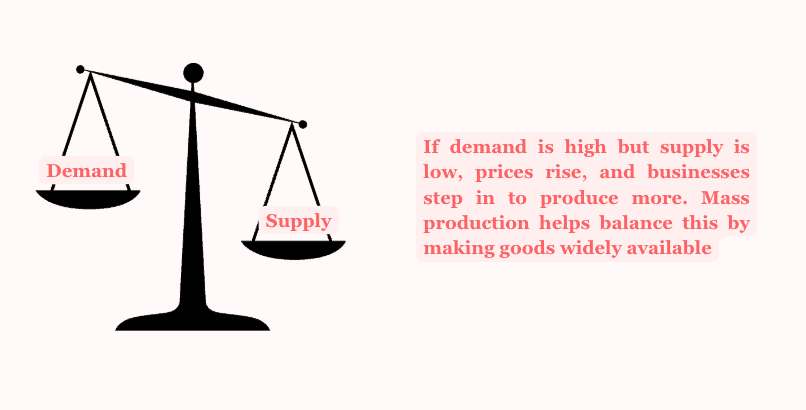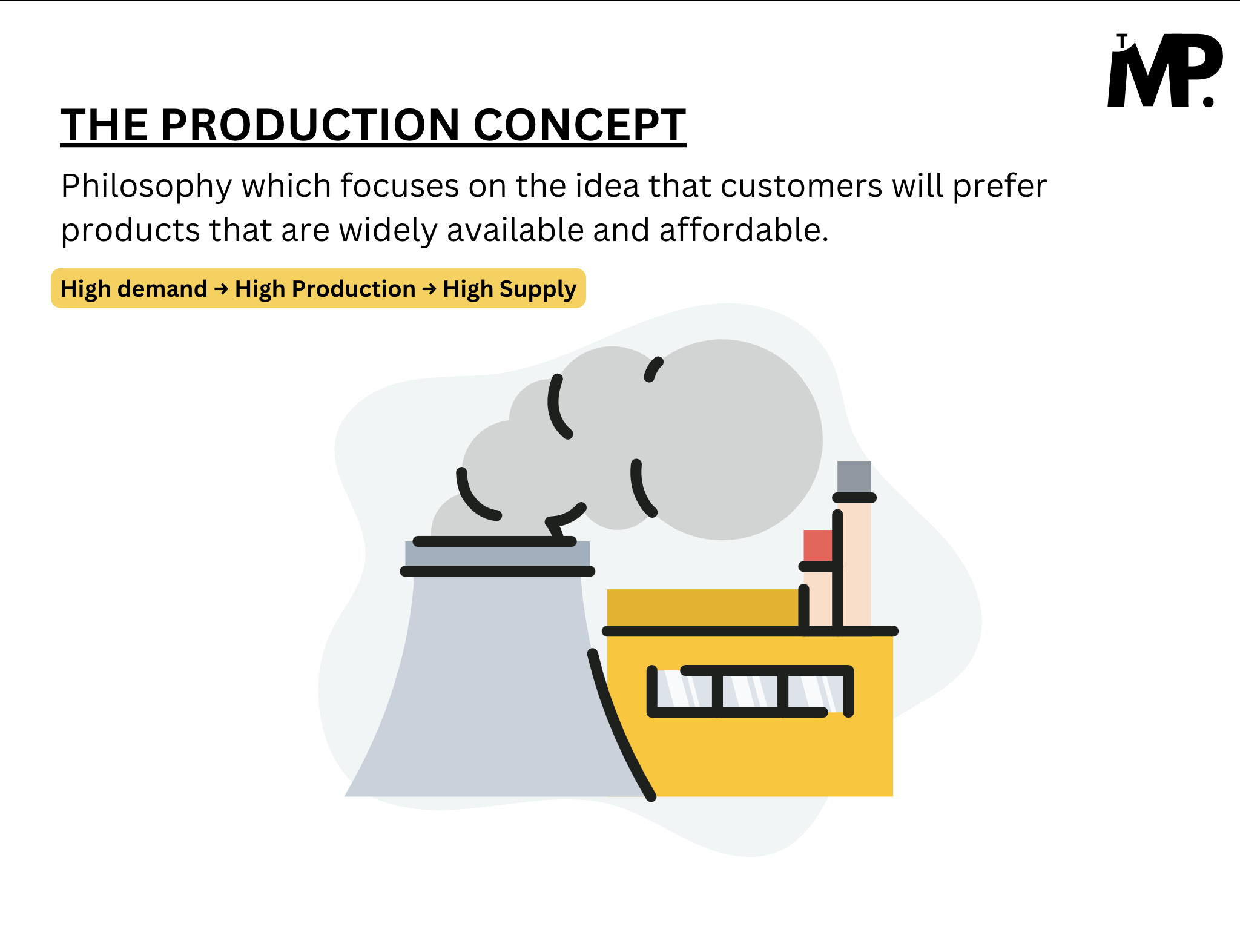That pack of instant noodles. The budget smartphone in your hand. The soda bottle stacked on every store shelf.
Have you wondered why some products are incredibly affordable and available everywhere?
These aren’t just random products—they’re the result of a business philosophy that has shaped industries for decades:
The Production Concept.
The world of marketing is built on five marketing concepts, each representing a different way businesses approach their customers. Among these, the Production Concept stands out as a strategy rooted in practicality.
This approach has driven industries for over a century. It influences how businesses operate and reduce costs along with delivering mass-produced goods to customers.
But is it still relevant today?
Let’s break it down, step by step.
What is the Production Concept?
The Production Concept is a marketing philosophy which holds high production efficiency, low costs, and mass distribution.
In simple words: “Make it cheap. Make it fast. Sell as much as possible.”
The idea is that customers prioritize affordability and availability over anything else.
Companies following this concept believe that the more they produce at a lower cost, the more customers will buy.

To really understand this approach, here are the four main pillars that define the Production Concept:
- Mass Production → Produce as many units as possible to lower costs.
- Cost Efficiency → Find ways to reduce manufacturing expenses.
- Wide Distribution → Get the product in as many stores and locations as possible.
- Basic Product Offerings → Keep features simple and avoid unnecessary extras.
Companies that follow this model believe that customers value affordability and accessibility over uniqueness or luxury.
But where did this idea originate?
The Origin of the Production Concept
The Production Concept traces back to the Industrial Revolution (18th–19th century).
This was when businesses realized they could produce more, faster, and cheaper by shifting from manual labor to machine-powered factories. The idea was simple: the more products a company makes, the lower the cost per unit, and the more people can afford them.

Fast forward to the early to mid-20th century, and the Production Concept became the dominant business strategy. Companies focused on mass-producing goods to meet the needs of a rapidly growing population. But here’s the key difference:
- Back then, communication was limited, and long-distance travel was difficult.
- Businesses relied on salesmen rather than advertising to promote their products.
- Distribution was a challenge, so companies had to make products widely available to reach customers.
Even with these hurdles, selling was easier than today. Why? Because there weren’t many options. Demand was high, and competition was low, meaning products often sold quickly simply because they were available.
One of the biggest reasons the Production Concept gained traction was a powerful economic principle called Say’s Law, introduced by French economist Jean-Baptiste Say. His theory can be summed up in one sentence:
“Supply creates its own demand.“
Jean-Baptiste Say
In simpler words: If you produce enough of something, people will buy it.
At that time, consumers had fewer choices and less information about products. Marketing wasn’t as sophisticated as it is today, and people bought what was available. As a result, companies focused almost entirely on mass production rather than branding, advertising, or differentiation.
This mindset still exists today in industries where cost and availability matter more than uniqueness. Think about fast food, basic clothing, or low-cost consumer electronics—businesses that prioritize efficiency and production often dominate these markets.
How Does the Production Concept Work?
So, how do businesses actually apply the Production Concept in the real world?
It’s all about three core strategies:
1. Maximizing Output (Produce More, Spend Less)
The goal is to produce as many products as possible in the shortest time.
This is done using factories, automation, and streamlined processes.
For example, Toyota’s lean manufacturing system helps produce cars faster with minimal waste.
2. Cutting Costs (Keep Prices Low to Attract More Buyers)
Companies find ways to lower expenses by:
- Using cheaper raw materials.
- Moving production to low-cost labor markets.
- Implementing automation to reduce human labor costs.
For example, Fast-food chains like McDonald’s use standardized recipes and efficient cooking methods to serve millions daily at a low cost.
3. Mass Distribution (Make the Product Available Everywhere)
The product should be easily accessible in physical stores, online platforms, and international markets.
The idea is: The more places it’s available, the more people will buy it.
For example, Coca-Cola uses a global distribution network, ensuring you can find a Coke almost anywhere in the world.
Examples of the Production Concept
Countries like China are prime examples of the production concept in action. Through rapid industrialization, China became a global manufacturing powerhouse, focusing on mass production and low costs. This efficiency has solidified its position as the world’s largest exporter, delivering vast quantities of affordable products worldwide.
Big brands such as Walmart, Ford, and Coca-Cola also embody the production concept:
Walmart: The retail giant optimizes its supply chain and leverages economies of scale, allowing it to offer low prices while maintaining profitability.
Ford: Its revolutionary assembly line streamlined car production, making vehicles affordable to the mass market.
Coca-Cola: By producing beverages in bulk and ensuring efficient global distribution, Coca-Cola has maintained its status as a leading global brand.
These examples demonstrate how focusing on efficiency, cost reduction, and volume drives success under the production concept.
But does this strategy work for every industry? Not always.
When is the Production Concept Most Effective?
The Production Concept is powerful, but it doesn’t fit every business model. It works best in these situations:
1. When Demand is Higher Than Supply

If there’s a high demand but a low supply, mass production helps fill the gap.
For example, Affordable smartphones in developing countries.
2. When People Need the Product (Not Just Want It)
Essential goods like food, medicine, or basic clothing work well under this concept.
Example: Generic medicine manufacturers keep costs low to ensure access for everyone.
3. When Cost Matters More Than Features
Some customers prioritize affordability over luxury or customization.
Example: Budget airlines focus on cheap tickets over premium experiences.
But here’s the problem: The Production Concept has major limitations.
Limitations of the Production Concept
While the Production Concept helped industries grow, it has some major flaws.
- It ignores customer needs. Just because something is cheap doesn’t mean people want it. Customers today expect quality, design, and customization.
- The product overproduction is a limitation here. It can lead to unsold stock and wasted resources.
- It assumes products sell themselves if they’re cheap and available. But in today’s world, branding and marketing are crucial.
- To keep costs low, companies may cut corners, leading to poor-quality products.
This is why many businesses shift away from the Production Concept and focus on customer needs instead.
Production Concept vs. Other Marketing Concepts
The Production Concept is just one of five major marketing philosophies. How does it compare?
1. Production Concept vs. Product Concept
- Production Concept → Focuses on efficiency & cost.
- Product Concept → Focuses on quality & innovation.
- Example: Apple (Product Concept) vs. Xiaomi (Production Concept).
2. Production Concept vs. Selling Concept
- Production Concept → Assumes cheap & available = sales.
- Selling Concept → Focuses on aggressive promotion.
- Example: Insurance companies use selling tactics, not just production.
3. Production Concept vs. Marketing Concept
- Production Concept → Focuses on making products.
- Marketing Concept → Focuses on customer satisfaction.
- Example: Nike prioritizes branding & customer needs, not just production.
While the Production Concept still works for some industries, most companies today focus on marketing-driven strategies.
Is the Production Concept Still Relevant Today?
Yes, but with modern adaptations.
Today, there are many companies using the production concept today.
For example, Xiaomi and Realme are the budget texh brands that offer high specs at a low price.
However, modern challenges that brands face are;
- Sustainability Issues → Mass production can harm the environment.
- Consumer Preferences → People want quality & ethics, not just low prices.
- Brand Loyalty → Customers choose brands, not just cheap products.
So, is the Production Concept outdated?
Not entirely—but businesses today need a balanced approach that includes efficiency + customer focus.
Final Thoughts: Should Businesses Follow the Production Concept?
The Production Concept is powerful but limited.
It works best in price-sensitive markets where availability matters more than features.
It fails when customer expectations shift toward quality, customization, and branding.
The business world has changed, and so has marketing.
While the Production Concept laid the foundation for mass production, companies today must adapt to survive.

1 Comment